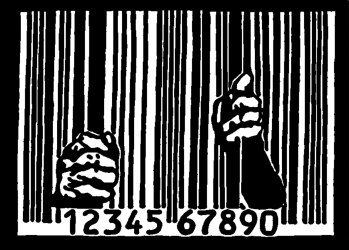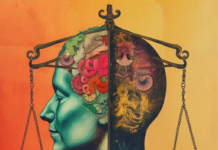Disability Studies scholars Alicia A. Broderick and Robin Roscigno argue that popular metaphors that portray autism as an enemy, alien, epidemic contagion, or otherwise dangerous serve to create a market for what they term the “Autism Industrial Complex.”
Broderick and Roscigno see these notions of autism as suggesting invasive behavioral techniques as the only plausible response. The researchers describe the business logic and surrounding discourses that legitimize coercive bodily control (and other forms of violence) over those diagnosed with autism.

Critical social and cultural analyses have pointed out that autistic people, including very young children, constitute a vast market for techniques of intervention levied by certified behavior technicians. Despite what some have called the “scientism of autism,” these diagnoses have come to profoundly shape contemporary debates about identity and normality. For example, the neurodiversity movement has emerged to depathologize traits, experiences, and ways of existing that are categorized as disorders. Still, other critiques focus on major “advocacy” organizations that have considerable funding for perpetuating dominant, often harmful ideas about autism.
Broderick and Roscigno, from Montclair State University and Rutgers University, respectively, deploy cultural studies and political economy as analytic frameworks to explore how autism has become big business. They argue that the “Autism Industrial Complex” (AIC) sustains and monopolizes a cultural logic of intervention upon those diagnosed by capitalizing on intervention services, certifications, ideas, and information about autism.
The authors deploy the notion of the AIC as a heuristic for documenting and analyzing the spheres of cultural politics and political economy that shape the understanding of autism and call for intervention. They build upon Albrecht’s model from the early ’90s that connects the production of autism as a “social problem” with the institutional response to that “problem.” Once an industrial complex (e.g., a set of circumstances around which institutional financial activities coalesce) is formed, there are sufficient incentives for the reproduction of that diagnosis irrespective of its utility for those diagnosed.
In their notion of the AIC, the medical-industrial complex and the education industrial complex create a series of networks that promote their products and services to generate profit. These networks also generate the ideas and beliefs that make these products and services appear necessary and legitimate.
The main “players” in the AIC are academic behaviorists, psychologists/psychiatrists, non-autistic parents of autistic children, the Behavior Analyst Certification Board (a private, non-profit corporation established in 1999 that certifies behavior analysts), and the advocacy/policy lobbying organization, Autism Speaks. Charting these interests, Broderick and Roscigno write:
“We fear (and assert) that the AIC is driven not by the interests of autistic individuals but by the interests of those who stand to profit from the AIC. Additionally, we contend that the costs to autistic people of the proliferation of the AIC have generally been regarded, thus far, as insignificant in the face of its profitability.”
Yet, this profit-generating infrastructure, they claim, is only the autism industry. Only the serendipitous historical conditions that wed the popularity of behaviorism to autism’s emergence, alongside the ascent of global, neoliberal capitalism fully constitute the AIC. Asking what, in addition to products and services, are sold by the AIC, they write:
“…the central product that the autism economy is producing and marketing for public consumption… is autism itself, and that the integrally intertwined, complementary constituent product—that the AIC ‘is selling you’—is the cultural logic of intervention.”
Discussing the fact that disabled people often do not enter the economy as wage laborer/consumers, they suggest that autistic individuals are “constructed as possessing a born indebtedness through the rhetoric of the AIC.” This debt comes in the form of education and therapy, estimated to exceed a total national cost of $461 billion per year in the US by 2025.
Rhetorically, narratives of hope and fear, abetted by professionalizing legitimization (e.g., certification, evidence-basing, etc.), produce the need for and consent to interventions for autism. Accordingly, autistic identities are manufactured to be exploited as unwitting or unwilling raw material for profit extraction. They deride such identities as “cynical, bigoted, [and] culturally devalued notion[s] of autism itself.”
Nevertheless, movements like the Neurodiversity/Autistic Pride, organizations like the Autistic Self Advocacy Network (ASAN) and Autistic Women and Non-Binary Network (AWN), and mutual aid projects forge coalitions for resistance and help direct capital toward, rather than away from, autistic people. Such efforts have made material gains for autistic people in education, health care, employment, and housing. They have also wrested some narrative power away from dominant “advocacy” groups comprised primarily of non-autistic people.
The authors point to collectives of autistic people who evade the apparatus of the AIC. They operate in “stealth mode” or off the grid of formal educational and medical industries entirely. They develop schooling and employment methods where their talents are valued, and their interests and strengths may be developed freely.
****
Broderick, A. A., & Roscigno, R. (2021). Autism, Inc.: The Autism Industrial Complex, Journal of Disability Studies in Education, 1-25. https://doi.org/10.1163/25888803-bja10008 (Link)















“Once an industrial complex (e.g., a set of circumstances around which institutional financial activities coalesce) is formed, there are sufficient incentives for the reproduction of that diagnosis irrespective of its utility for those diagnosed.”
Well stated, and this is true for all the psychiatric DSM disorders. And why the DSM is still being utilized, despite being confessed to be scientifically “invalid,” eight years ago.
https://www.nimh.nih.gov/about/directors/thomas-insel/blog/2013/transforming-diagnosis.shtml
As the old adage goes, “It is difficult to get a man to understand something, when his salary depends on his not understanding it.” And it’s even worse, when dealing with completely deluded “industrial complexes,” like the “mental health” industrial complex.
Report comment
“It is difficult to get a man to understand something, when his salary depends on his not understanding it.”
That’s a good one. I hope you don’t mind me stealing it.
As someone who works at a boarding school for autistic adolescents, I agree with the text. Some decisions are clearly made with money being a higher priority than the wellbeing of the kids. Others seem rooted in some form of helpers complex.
Every last bit of mental distress gets attributed to autism. Even when it very clearly is caused by e.g. abusive parents.
Report comment
Once you have a label, everything is either attributed to it, or it is mentioned alongside. The drugs and it’s enormous brain and physical changes is never mentioned.
Once drugs enter, we no longer have any idea at what the real issues are.
I’m glad a person with some understanding is working in the here and now to understand and accept as much as possible. You deserve every penny you get.
Thing with abusive parents or systems, they are rarely aware of being contributors to stress. Adopted dogs have a better chance, but we tend to have much more patience with stressed dogs than we do with kids or adults.
There is something satisfying in getting a dog out of depths of despair and fears and get them to be social and even brave and confident. And that NEVER happens unless the environment and care is completely altered.
Dogs NEVER get “better” with drugs.
When you get an insane dog and start with lots of bonding and fun, lots of car trips and walks to nature and swimming, free running, tug of war, cuddles and belly rubs, eventually, touching paws and teeth, sharing your yoghurt, relaxation occurs. This does not occur by taking them to “behavioral” classes or using controlled environments.
Thing is, what we should aim for in “care” is quality of life with ability for some happiness. Psychiatry is not familiar with real happiness, contentment. It is not about “function” it is about much more.
Report comment
It’s not my adage, it’s Upton Sinclair’s. An adage is a “general truth … that has gained credit through long use.” Please speak common sense and the truth! We need more of that, from everyone!
But I will say, since autism is an “illness” created by the psychiatrists. Who claim ignorance of the fact that the ADHD drugs and antidepressants can create the “bipolar” symptoms.
https://www.alternet.org/2010/04/are_prozac_and_other_psychiatric_drugs_causing_the_astonishing_rise_of_mental_illness_in_america/
And their DSM “bible” is proof, they also claim ignorance of the fact that the antipsychotics / neuroleptics, the “gold standard schizophrenia treatments,” can create both the negative and positive symptoms of “schizophrenia,” via both NIDS and anticholinergic toxidrome.
https://en.wikipedia.org/wiki/Neuroleptic-induced_deficit_syndrome
https://en.wikipedia.org/wiki/Toxidrome
In other words, the large majority of psychiatrists consistently blame adverse drug effects on those they stigmatize. I will say, my research – and generally good gut instincts, including the fact I’d never heard of autism existing when I was young – lead me to believe autism may also likely be caused largely, by adverse effects of childhood vaccines, not just abusive parents.
Another good adage you might like to use, with those with a “helpers complex,” is this one by C. S. Lewis:
“Of all tyrannies, a tyranny sincerely exercised for the good of its victims may be the most oppressive. It would be better to live under robber barons than under omnipotent moral busybodies. The robber baron’s cruelty may sometimes sleep, his cupidity may at some point be satiated; but those who torment us for our own good will torment us without end for they do so with the approval of their own conscience.”
Report comment
I’m not a native english speaker, so my knowledge of english proverbs is limited. 😉
Luckily most people with autism diagnoses do not get “medicated”.
What you said about dogs reminded me of a truth I had long forgotten. Thanks for that.
Report comment
Since I’ve read a number of pieces by and about Temple Grandin, I’ve drifted away from popular notions about autism, although the squeeze machine sounds like an interesting idea.
Report comment
It all comes down to business as usual, with different language. However I’m tired of “Military-Industrial Complex” and “Prison Industrial Complex” being endlessly appropriated. (I do think “Prison/Psychiatric Industrial Complex” is a valid term however.)
Report comment
Maybe the Autism Industrial Complex would a sub-complex of the Prison/Psychiatric Industrial Complex.
And what about the COVID Industrial Complex?
Report comment
I posited this idea, though I had not yet found this reference when drafting part of my dissertation literature review this past month. I will be adding multiple references and additional points. I do not agree with the Marxist inspired Critical theory BS, but there is a lot of wisdom and logic in the notion that money drives the medical field. It’s always going to more profitable to treat a condition that cure one. As the neurodivergent (AuDHD) father of three teenage neurodivergent children, two of which who are AuDHD, I will say, there is nothing to cure, nor to treat. Everything in life for someone is AuDHD is about masking and adapting. The question is whether that masking and adapting will be learned pre-trauma or post-trauma. I learned most of mine over 28 years of military service; many of which while serving in places like Kosovo, Afghanistan and West Africa. I can only hope that mine will be the last generation where the symptoms of AuDHD were overlooked and ignored.
Report comment